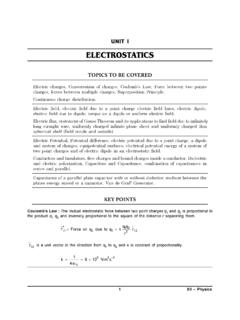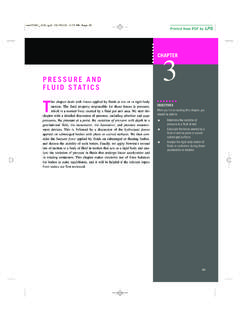Transcription of EFFICIENCY OF DAMAGE-PLASTICITY MODELS IN …
1 ECCOMAS Congress 2016 VII European Congress on Computational Methods in Applied Sciences and EngineeringM. Papadrakakis, V. Papadopoulos, G. Stefanou, V. Plevris (eds.)Crete Island, Greece, 5 10 June 2016 EFFICIENCY OF DAMAGE-PLASTICITY MODELS IN CAPTURINGCOMPACTION-EXPANSION TRANSITION OF CONCRETE UNDERDIFFERENT COMPRESSION LOADING CONDITIONSReza Mousavi1, Masoud D. Champiri2, and Kaspar J. Willam31 University of Houston, Department of Civil EngineeringHouston , TXe-mail: of Houston, Department of Civil EngineeringHouston , TXe-mail: of Houston, Department of Civil EngineeringHouston , TXe-mail: damage , plasticity , dilation, multiaxial pre- and post-peak performance features of two widely used damage -plasticityconstitutive formulations are assessed for modeling the multiaxial response behavior of pres-sure sensitive quasi-brittle materials such as concrete.
2 Two benchmark problems have beensolved using commercial software packages; ABAQUS which implements the two invariant Lee-Fenves damaged plasticity formulation as its main feature for concrete has been used along withLS-DYNA which is using Duvaut-Lion damage and plasticity model , a three invariant formula-tion. In order to have consistent results, the parameter identification and calibration for bothmodels has been performed and response of both MODELS has been compared to each other un-der uniaxial tension and compression. The two benchmark problem are triaxial compressionCTC and triaxial tension CTE. The aim of this study is to observe the difference between twowell-known material MODELS in capturing the compaction to extension regime in the yieldedmaterial.
3 The difference between the response of each material model and also the efficiencyof input parameters in controlling of this transition has been studied in this paper. Based onthese failure diagnostics, the main shortcomings of each formulation are discussed and possibleenhancements and remedies are proposed for the pre- and post-peak Mousavi, M. D. Champiri and K. J. Willam1 introductionThe usage of commercial packages is world wide and they have many applications in the hecomputational mechanics. Between these packages, for sure, ABAQUS [1] and LS-DYNA [2]have more interest than others. Since different material MODELS are developed in these packagesfor same material like concrete, it is necessary to compare them together and see how the usercan get similar results with implementing some parameters.
4 This can help them to use materialmodels widely and in different cases and concrete material MODELS have been developed and implemented in these packages. Dam-age and plasticity are two important features where users are looking for them in order to useconcrete material MODELS . In ABAQUS, concrete damaged plasticity model (CDP) [3, 4], iswidely used among researchers [5 8]. The constitutive formulation of this material model isreviewed in the following sections. Many concrete material MODELS are available in LS-DYNA where they consider damage and plasticity [9]. Karagozian and Case model (concrete dam-age model , MAT-72) [10], the Riedel-Hiermaier-Thoma model (RHT, MAT-272) [11, 12], theBrannon-Fossum model (BF1) [13], and Continuous surface cap model (CSCM, MAT-159) [14]are some of those.
5 Among them, MAT-159 has many applications in the literature [15, 16], be-cause this material uses two parameters including uniaxial compressive strength and maximumsize of aggregate in the simplest version for concrete structures, while other materials needmany inputs. This material model uses the Duvaut-Lions formulation [17] and its constitutivemodel will be addressed in the section 3 of this paper. As a result, these two material MODELS inABAQUS and LS-DYNA have been selected and their behavior is compared together. It is triedto find a way to make their behavior closer to each other with implementing a parameter this, their behavior is compared in uniaxial compression test, uniaxial tension test. Later on,with adopted parameters, the behavior of these material MODELS is investigated in case of triax-ial compression test (CTC), triaxial extension test (CTE) and bi-axial compression test.
6 Thesetests can be also done experimentally as Kupfer [18]. In order to compare the with theexperimental results, one option to observe a more general localized behavior of concrete underdifferent levels of confinement, full field measurment techniques like digital image correlation(DIC) method can be utilized [19 22]. A remarkable feature that can be pointed out about postprocessing of digital image correlation system is their feasibility in being implemented in ex-pert systems. Champiri et al [23, 24]developed some expert systems for concrete structures andstructural health monitoring with developing a fuzzy method. The parameter study is conductedin section 4 and the most efficient parameters are selected for performing different tests.
7 Alsoit is noted that each material model has some deficiencies as well as some advantages in somepoints. Some concluding remarks are investigated in section Concrete Damaged plasticity modelIn this model , the admissible stress state has the condition of [4]:F( ,ft,fc) 0(1)In which,ft=ft( t), fc=fc( c)are tensile and comressive uniaxial strengths which arewritten as functions of damage parameter respectively. By rearranging uniaxial strength valuesas function of scalar degradation, the relation between the effective strength and strength is asfollow:ft= (1 Dt( t)) ft( t), fc= (1 Dc( c)) fc( c)(2)2R. Mousavi, M. D. Champiri and K. J. WillamThe damage variable in CDP model is defined as scalar quantity which is different in compres-sion and tension [3].
8 The uniaxial version of this parameter is defined as follow: = p0 ( p)d p 0 ( p)d p(3)Here,g = 0 ( p)d pis called dissipated energy density per unit volume. This quantity hasbeen obtained by regularization of fracture energy in tensile and compressive state(G )withrespect to characteristic element size(l )asg =G /l . the relation between stress an strainis written as follow: =f 0((1 +a )e b p a e 2b p)(4)In which,a ,b are constants. The relation between degradation and plastic strain is written as:1 D =e d p(5)By taking into account degradation, the effective stress is calculated as follow: =f 0((1 +a )(e b p)1 d b a (e b p)2 d b )(6)By combining eq.( 4 ),(6) with eq.( 5), we have:g =f 0b (1 +a 2)(7) =f 0a ((1 +a ) ( ) ( ))(8)By eq.
9 (8) and (3), the damage evolution law in the uniaxial test is obtained by: =1g f ( ) p(9)For the case of compressive stress, a damage value of chas been assumed when compressivestress is at its peak which gives corresponding degradation value ofDcas an input parameterfor the material model which will be discussed in following. By putting this damage value intoeq. refeqstress2, we will have following: ( c) =1 +ac2 Dc= 1 (1ac(1 +ac 1 +ac2))dcbc(10)SinceDcis measured from experiment, we can obtaindc/bcby equation:dcbc=log(1 Dc)log(1+ac2ac)(11)In the case of tensile loading, since the stress diagram is descending from the beginning ofplastification, a tensile degradation valueDtwill be considered at the point where stress valueis half of the value of tensile strength( t=ft0/2)).
10 For this case, we have: ( t) =1 +at+ 1 +a2t2(12)dtbt=log(1 Dt)log((1 +at) 1 +a2t) log 2at(13)3R. Mousavi, M. D. Champiri and K. J. Willam3 Material 159 The yield function for this material model reads as [14]: 159(I1,J2,J3, ) =J2 <2F2fFc(14)in which,Ff(I1),Fc(I1, ),<(J2,J3)are functions which are taking into shear surface, cap re-gion and Rubin scaling factor [25], (I1) = e 0I1+ I1(15)Fc(I1, ) ={1 (I1 )2(X )2:I1 01:otherwise(16)<(J2,J3) = b1+ b21 4b1b02b2(17)L( ) ={ : > 0 0: 0(18)X( ) =L( ) +R0Ff(L( ))(19)By Definition:b0= 3 +b a24(20a)b1=a(cos asin )(20b)b2= (cos asin )2+bsin2 (20c)b= (2Q1+a)2 3a= a1+ a21 4a2a02a2(20d)a0= 2Q21(Q2 1)(20e)a1= 3Q2+ 2Q1(Q2 1)(20f)a2=Q2(20g)sin 3 =3 3J32J3/22(20h)Q1andQ2are the parameters which determine the yield surface parameters that we want to a generalized form.}}






